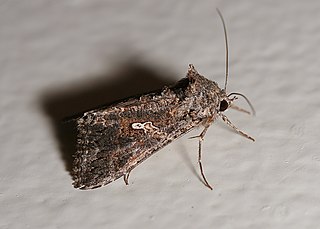
The Noctuidae, commonly known as owlet moths, cutworms or armyworms, are a family of moths. They are considered the most controversial family in the superfamily Noctuoidea because many of the clades are constantly changing, along with the other families of the Noctuoidea. It was considered the largest family in Lepidoptera for a long time, but after regrouping Lymantriinae, Catocalinae and Calpinae within the family Erebidae, the latter holds this title now. Currently, Noctuidae is the second largest family in Noctuoidea, with about 1,089 genera and 11,772 species. This classification is still contingent, as more changes continue to appear between Noctuidae and Erebidae.

Helicoverpa zea, commonly known as the corn earworm, is a species in the family Noctuidae. The larva of the moth Helicoverpa zea is a major agricultural pest. Since it is polyphagous during the larval stage, the species has been given many different common names, including the cotton bollworm and the tomato fruitworm. It also consumes a wide variety of other crops.
Juvenile hormones (JHs) are a group of acyclic sesquiterpenoids that regulate many aspects of insect physiology. The first discovery of a JH was by Vincent Wigglesworth. JHs regulate development, reproduction, diapause, and polyphenisms.The chemical formula for juvenile hormone is .

A spermatophore or sperm ampulla is a capsule or mass containing spermatozoa created by males of various animal species, especially salamanders and arthropods, and transferred in entirety to the female's ovipore during reproduction. Spermatophores may additionally contain nourishment for the female, in which case it is called a nuptial gift, as in the instance of bush crickets. In the case of the toxic moth Utetheisa ornatrix, the spermatophore includes sperm, nutrients, and pyrrolizidine alkaloids which prevent predation because it is poisonous to most organisms. However, in some species such as the Edith's checkerspot butterfly, the "gift" provides little nutrient value. The weight of the spermatophore transferred at mating has little effect on female reproductive output.

The cabbage looper is a medium-sized moth in the family Noctuidae, a family commonly referred to as owlet moths. Its common name comes from its preferred host plants and distinctive crawling behavior. Cruciferous vegetables, such as cabbage, bok choy, and broccoli, are its main host plant; hence, the reference to cabbage in its common name. The larva is called a looper because it arches its back into a loop when it crawls.

Bombykol is a pheromone released by the female silkworm moth to attract mates. It is also the sex pheromone in the wild silk moth. Discovered by Adolf Butenandt in 1959, it was the first pheromone to be characterized chemically.

Greta oto is a species of brush-footed butterfly and member of the subfamily Danainae, tribe Ithomiini, and subtribe Godyridina. It is known by the common name glasswing butterfly for its transparent wings, which allow it to camouflage without extensive coloration. In Spanish speaking regions, it may also be referred to as espejitos, meaning "little mirrors" because of its transparent wings. The butterfly is mainly found in Central and northern regions of South America with sightings as far north as Texas and as far south as Chile. While its wings appear delicate, the butterfly is able to carry up to 40 times its own weight. In addition to its wing physiology, the butterfly is known for behaviors such as long migrations and lekking. Greta oto closely resembles Greta andromica.

The garden tiger moth or great tiger moth is a moth of the family Erebidae. Arctia caja is a northern species found in the US, Canada, and Europe. The moth prefers cold climates with temperate seasonality, as the larvae overwinter, and preferentially chooses host plants that produce pyrrolizidine alkaloids. However, garden tiger moths are generalists, and will pick many different plants to use as larval host plants.

Pyrrolizidine alkaloids (PAs), sometimes referred to as necine bases, are a group of naturally occurring alkaloids based on the structure of pyrrolizidine. Pyrrolizidine alkaloids are produced by plants as a defense mechanism against insect herbivores. More than 660 PAs and PA N-oxides have been identified in over 6,000 plants, and about half of them exhibit hepatotoxicity. They are found frequently in plants in the Boraginaceae, Asteraceae, Orchidaceae and Fabaceae families; less frequently in the Convolvulaceae and Poaceae, and in at least one species in the Lamiaceae. It has been estimated that 3% of the world’s flowering plants contain pyrrolizidine alkaloids. Honey can contain pyrrolizidine alkaloids, as can grains, milk, offal and eggs. To date (2011), there is no international regulation of PAs in food, unlike those for herbs and medicines.

The European corn borer, also known as the European corn worm or European high-flyer, is a moth of the family Crambidae which includes other grass moths. It is a pest of grain, particularly maize. The insect is native to Europe, originally infesting varieties of millet, including broom corn. The European corn borer was first reported in North America in 1917 in Massachusetts, but was probably introduced from Europe several years earlier. Since its initial discovery in the Americas, the insect has spread into Canada and westward across the United States to the Rocky Mountains.
Sex pheromones are pheromones released by an organism to attract an individual of the same species, encourage them to mate with them, or perform some other function closely related with sexual reproduction. Sex pheromones specifically focus on indicating females for breeding, attracting the opposite sex, and conveying information on species, age, sex and genotype. Non-volatile pheromones, or cuticular contact pheromones, are more closely related to social insects as they are usually detected by direct contact with chemoreceptors on the antennae or feet of insects.
In enzymology, a senecionine N-oxygenase (EC 1.14.13.101) is an enzyme that catalyzes the chemical reaction

Utetheisa ornatrix, also called the bella moth, ornate moth or rattlebox moth is a moth of the subfamily Arctiinae. It is aposematically colored ranging from pink, red, orange and yellow to white coloration with black markings arranged in varying patterns on its wings. It has a wingspan of 33–46 mm. Moths reside in temperate midwestern and eastern North America as well as throughout Mexico and other parts of Central America. Unlike most moths, the bella moth is diurnal. Formerly, the bella moth or beautiful utetheisa of temperate eastern North America was separated as Utetheisa bella. Now it is united with the bella moth in Utetheisa ornatrix.

Senecionine is a toxic pyrrolizidine alkaloid isolated from various botanical sources. It takes its name from the Senecio genus and is produced by many different plants in that genus, including Jacobaea vulgaris. It has also been isolated from several other plants, including Brachyglottis repanda, Emilia, Erechtites hieraciifolius, Petasites, Syneilesis, Crotalaria, Caltha leptosepala, and Castilleja.
Pyrrolizidine alkaloid sequestration by insects is a strategy to facilitate defense and mating. Various species of insects have been known to use molecular compounds from plants for their own defense and even as their pheromones or precursors to their pheromones. A few Lepidoptera have been found to sequester chemicals from plants which they retain throughout their life and some members of Erebidae are examples of this phenomenon. Starting in the mid-twentieth century researchers investigated various members of Arctiidae, and how these insects sequester pyrrolizidine alkaloids (PAs) during their life stages, and use these chemicals as adults for pheromones or pheromone precursors. PAs are also used by members of the Arctiidae for defense against predators throughout the life of the insect.

Hair-pencils and coremata are pheromone signaling structures present in lepidopteran males. Males use hair-pencils in courtship behaviors with females. The pheromones they excrete serve as both aphrodisiacs and tranquilizers to females as well as repellents to conspecific males. Hair-pencil glands are stored inside the male until courtship begins, at which point they are forced out of the body by sclerotized levers present on the abdomen. Coremata are very similar structures. Their exact definition is confused by early descriptions but they are more specifically defined as the internal, glandular, eversible structures that bear the hair-pencils and can be voluntarily inflated with hemolymph or air.

Creatonotos gangis is a species of arctiine moth in South East Asia and Australia. It was described by Carl Linnaeus in his 1763 Centuria Insectorum.

Jerrold Meinwald was an American chemist known for his work on chemical ecology, a field he co-founded with his colleague and friend Thomas Eisner. He was a Goldwin Smith Professor Emeritus of Chemistry at Cornell University. He was author or co-author of well over 400 scientific articles. His interest in chemistry was sparked by fireworks done with his friend Michael Cava when they were still in junior high school. Meinwald was also a music aficionado and studied flute with Marcel Moyse – the world's greatest flutist of his time.

Thomas Hartmann,, was a German pharmaceutical biologist and ecologist who was professor in the Department of Pharmaceutical Biology at the Technische Universität Braunschweig. His research focused on the biosynthesis, intracellular transport, and action of quinolizidine and pyrrolizidine alkaloids in fungi and plants and the sequestration of these secondary natural products by insects.

Kleptopharmacophagy is a term used for describing the ecological relationship between two different organisms, where the first is stealing the second's chemical compounds and consuming them. This scientific term was proposed by Australian, Singaporean, and American biologists in September 2021 in an article that was published in the journal Ecology by the Ecological Society of America. The phenomenon was first noticed in milkweed butterflies that were attacking caterpillars and drinking their internal liquid, proposedly to obtain toxic alkaloids used for defense, as well as for mating purposes.

















